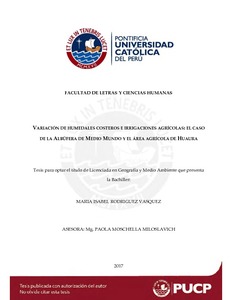| dc.contributor.advisor | Moschella Miloslavich, Paola | |
| dc.contributor.author | Rodriguez Vasquez, Maria Isabel | es_ES |
| dc.date.accessioned | 2017-09-29T16:09:28Z | es_ES |
| dc.date.available | 2017-09-29T16:09:28Z | es_ES |
| dc.date.created | 2017 | es_ES |
| dc.date.issued | 2017-09-29 | es_ES |
| dc.identifier.uri | http://hdl.handle.net/20.500.12404/9410 | |
| dc.description.abstract | La pérdida y degradación global de los humedales costeros se relacionan con el uso
intensivo del agua en las actividades humanas y el desconocimiento del impacto de este
uso sobre los humedales. Ante dicho escenario, el objetivo principal de este estudio fue
aportar al conocimiento sobre los humedales de la costa árida peruana y su relación con
las irrigaciones agrícolas, considerando la influencia del uso del agua de regadío en la
formación, los cambios de extensión y la sostenibilidad de estos ecosistemas. Para ello, se
abordó el caso de la Albúfera de Medio Mundo y la irrigación San Felipe, ubicados en la
provincia de Huaura, departamento Lima.
A través del análisis multitemporal de imágenes aeroespaciales, la revisión bibliográfica,
observaciones de campo y entrevistas; se determinaron: la variación de la superficie hídrica
de la Albúfera; los cambios históricos en el uso agrícola del agua en la irrigación San Felipe
y las actividades que influyen en el balance hídrico del acuífero de la intercuenca San
Felipe-Medio Mundo.
Los resultados mostraron que la implementación del riego en la irrigación San Felipe
propició la formación de la Albúfera de Medio Mundo. Posteriormente, la eficiencia de
riego en San Felipe se duplicó, principalmente debido a la introducción de técnicas de riego
moderno y presurizado, lo que a su vez generó la ampliación del área bajo cultivo. Sin
embargo, la mejora en la eficiencia de riego reduce la recarga del acuífero y, por tanto, la
tendencia de la superficie hídrica del humedal es la disminución. Esta también es afectada
por la explotación de agua subterránea en actividades avícolas y el uso poblacional.
Esta investigación reafirma la ventaja del estudio de las interrelaciones entre los humedales
costeros y los otros usos de agua, tales como el agrícola, desde un enfoque geográfico; pues
facilita la comprensión holística e integral de las múltiples articulaciones. En ese sentido, y
con base a dicho enfoque, es necesario fomentar y aplicar la Gestión Integrada de los
Recursos Hídricos en las localidades costeras con presencia de humedales e irrigaciones. | es_ES |
| dc.description.abstract | The global loss and degradation of coastal wetlands is related to the intensive use of water
in human activities and the lack of awareness of the impact of this use on wetlands. In view
of this, the main objective of this study was to contribute to the knowledge about the
wetlands of the peruvian arid coast and its relation with agricultural irrigations,
considering the influence of the use of irrigation water in the formation, the changes of
extension and the sustainability of these ecosystems. For this, the case of the Medio Mundo
lagoon and San Felipe irrigation, located in the province of Huaura, Lima region, was
addressed.
Through multitemporal analysis of aerospace images, bibliographic review, field
observations and interviews were determined: the lagoon water surface’s variation; the
historical changes in the agricultural use of water in San Felipe irrigation and the activities
that influence the water balance of the San Felipe-Medio Mundo inter-basin’s aquifer.
The results showed that the implementation of San Felipe irrigation led to the formation of
the Medio Mundo lagoon. Subsequently, the irrigation efficiency in San Felipe doubled,
mainly due to the introduction of modern and pressurized irrigation techniques, which
allowed the increase of the area under cultivation. However, the improvement in irrigation
efficiency reduces aquifer recharge and, therefore, the tendency of the wetland’s water
surface is the decrease. This is also affected by the exploitation of groundwater in poultry
activities and population use.
This research reaffirms the advantage of studying the interrelationships between coastal
wetlands and other water uses, such as agriculture, from a geographic focus; since it
facilitates the holistic and integral understanding of the multiple articulations. In this sense
and based on this approach, it is necessary to promote and implement Integrated
Management of Water Resources in coastal locations with the presence of wetlands and
irrigations. | es_ES |
| dc.language.iso | spa | es_ES |
| dc.publisher | Pontificia Universidad Católica del Perú | es_ES |
| dc.rights | Atribución-NoComercial-SinDerivadas 2.5 Perú | * |
| dc.rights | info:eu-repo/semantics/openAccess | es_ES |
| dc.rights.uri | http://creativecommons.org/licenses/by-nc-nd/2.5/pe/ | * |
| dc.subject | Humedales--Perú--Lima | es_ES |
| dc.subject | Ecología de tierras húmedas | es_ES |
| dc.subject | Huaura (Lima : Provincia)--Geografía | es_ES |
| dc.title | Variación de humedales costeros e irrigaciones agrícolas: el caso de la Albúfera de Medio Mundo y el área agrícola de Huaura | es_ES |
| dc.type | info:eu-repo/semantics/bachelorThesis | es_ES |
| thesis.degree.name | Licenciado en Geografía y Medio Ambiente | es_ES |
| thesis.degree.level | Título Profesional | es_ES |
| thesis.degree.grantor | Pontificia Universidad Católica del Perú. Facultad de Letras y Ciencias Humanas | es_ES |
| thesis.degree.discipline | Geografía y Medio Ambiente | es_ES |
| renati.discipline | 532036 | es_ES |
| renati.level | https://purl.org/pe-repo/renati/level#tituloProfesional | es_ES |
| renati.type | http://purl.org/pe-repo/renati/type#tesis | es_ES |
| dc.publisher.country | PE | es_ES |
| dc.subject.ocde | https://purl.org/pe-repo/ocde/ford#5.07.00 | es_ES |






